With a length of a good 364 mm – incidentally 16 mm longer than specified in the technical specs – the MAKpro 5-25x56i HD is still one of the most compact riflescopes in its performance class. Depending on the firearm used, a scope that is not too long is welcome. Despite its compactness, the scope is not a feather, weighing in at 1,060 grams for the MAKpro 5-25x56i HD. This probably means that no expense was spared on the 7075 aluminum housing, which gives a good feeling when the rifle and optics are put under a bit more stress in practice. The reticle is located in the first focal plane, so it changes with the magnification and can be used to determine the distance.
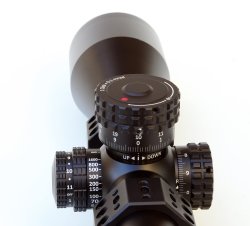
At the maximum magnification, the MAKpro 5-25x56i HD offers a bright, high-contrast image, sharp to the edge. The field of view of 145 cm at 100 m turns out to be somewhat smaller than the 1.5 m at 100 m stated by the manufacturer and rounded up, but at 25x magnification it is completely within the green range. The eye box is also good: 2.2 mm exit pupil at 25x magnification is common standard for a 56 mm lens. The eye relief (90 to 97 mm) was a positive feature in the test. This means that a steady image is quickly achieved when aiming. At 5x magnification, the field of view is just under 7.4 m – that's just a tad smaller than the renowned competition in the top segment. We also like that the reticle can be used with the 5x magnification. Because with many reticles located in the first focal plane, the sufficiently fine reticle at maximum magnification can hardly be seen at minimum magnification due to the small line width. MAK solved this very well.
Further technical details on the MAKpro 5-25x56i HD riflescope
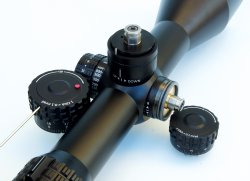
The Mil-Dot reticle is somewhat "outdated" in view of the current market trends in the field of long-range optics. Finer lines and marks that allow a measuring distance of 2 cm at 100 m and a "Christmas tree" are more "up to date" here. As a countermovement to this trend, however, there are also shooters who want a calmer target image, especially in the center. A fine dot is then sufficient. That's where the central dot of the MAKpro 5-25x56i HD with a coverage of 4.5 mm at 100 meters would fit, because at that range from this point there is 2 cm of free space in each direction before the lines begin. At 1,000 meters, it would then be a dot that covers 4.5 cm and provides a radial clearance of 20 cm. Some manufacturers offer customers a choice of different reticles, but the MAKpro 5-25x56 i HD only has the one option so far. The illuminated reticle has 11 light settings, each with an intermediate setting where the illumination is turned off. This offers the advantage of being able to immediately return to the last setting when switched on. An automatic switch-off function is not available.
Technology check: the adjustment mechanism of the MAKpro 5-25x56i HD
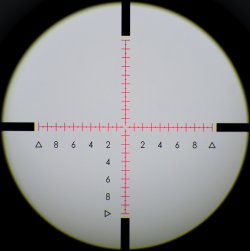
The settings for illumination, magnification and parallax compensation all worked flawlessly – no play, no irregularities. The parallax compensation offers a lot of information, starting at 25 meters, quite a few distances are engraved into the scale ring. In the test, we could see for ourselves that the distances engraved on the adjustment ring from 25 meters to 50 meters and 100 meters matched the actual distances. The adjustment ring of the parallax compensation can be moved with a noticeable resistance, but this prevents unintentional adjustment. The reticle adjustment turrets are grippy, click cleanly, and are easy to read. The click adjustment here works at 0.1 mrad per click, or 1 cm at 100 yards. Both turrets offer 100 clicks per revolution. It is necessary for a long-range scope that the elevation adjustment is sufficiently large. A 300-m distance is not a challenge, but at 1,000 yards/914 meters, things get a little more exciting. Based on a sighting-in distance of 100 meters, it should be possible to correct around 110 clicks with a caliber such as .308 Winchester, depending on the load and bullet velocity. Theoretically, this requires an elevation adjustment range of at least 220 clicks. This number of clicks is necessary because the reticle of the riflescope is usually centered during mounting.
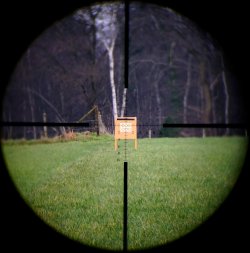
For simplicity, we have disregarded the mounting elevation and trajectory of the bullet up to the sighting-in distance of 100 meters. According to the technical data in the manual, the MAKpro 5-25x56 i HD has an elevation adjustment range of ±50 MOA or ±146 cm at 100 meters, with the English-language manual stating 280 clicks total. To verify this, we disassembled the turret cap and turned the reticle elevation adjustment axis completely down, then counted the clicks as we turned it up. We were amazed when we counted 322 clicks! At half of 322 clicks, or 161 clicks, this scope has a wide enough range of adjustment to use a caliber like .308 Winchester at 1,000 yards. The red indicator pin on the elevation turret head comes out as soon as the turret passes the "-0-" mark for the first time during elevation. This signals that 100 clicks have already been turned up. The indicator only shows the transition from the first to the second revolution. The third revolution is no longer displayed. For the maximum windage setting, 25 MOA (73 cm at 100 m) is mentioned. With the test scope, it was 187 clicks, also considerably more than stated in the technical data.
MAKpro 5-25x56i HD riflescope, easy to zero
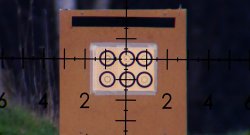
The scope can be zeroed quite easily and has an adjustable zero stop. This is how zeroing works: simply loosen the three grub screws on the windage turret and align the zero mark on the scale on the turret cap with the zero mark on the turret. When zeroing the elevation turret, it's even easier – here you only have to loosen one grub screw before the procedure, adjust it, tighten it gently, and you're done. The zero stop is mounted in the elevation turret as part of the rotation indicator.
To adjust the stop, the turret must be pulled from the elevation adjustment axis, whose receptacle is designed as a hexagon. This means that the turret can be repositioned 1/6 of a full turret revolution at a time. With 100 clicks divided by the 6 positions, this corresponds to about 17 clicks. This means that the stop almost always offers the possibility to set some minus clicks as well. The clicks below zero are not a fixed value. Depending on the position of the turret on the axis and the setting of the zeroing, this value can vary.
MAKpro 5-25x56i HD riflescope specs and price
| Manufacturer: | Kilic Feintechnik GmbH |
| Model: | MAKpro 5-25x56i HD |
| Magnification: | 5 - 25x |
| Objective Lens Diameter: | 56 mm |
| Main Tube Diameter: | 34 mm |
| Field of View (at 100 m): | 7.4 m to 1.5 m |
| Diopter Adjustment Range: | -1.5 to +1 dpt |
| Parallax Adjustment: | 25 m-∞ |
| Adjustment per Click (at 100 m): | 1 cm |
| Elevation Adjustment Range (at 100 m): | ±146 cm |
| Elevation Adjustment Range (at 100 m): | ±73 cm |
| Reticle: | MRAD-based illuminated reticle in the 1st focal plane |
| Length: | 348 mm |
| Weight: | 1,015 g |
| Price (MSRP): | 3.400 euro |
MAKpro 5-25x56i HD riflescope: our test conclusion
In terms of optical performance, the MAKpro 5-25x56 i HD is on the same level as renowned long range riflescopes from the premium segment. Mechanically, the adjustment turrets run like clockwork. The parallax compensation also deserves praise. Another plus point goes to the height adjustment range of the test scope: 322 clicks are quite a number. However, our tester subtracts some points for the reticle, which is no longer up to date, and the missing alternative reticle options. With the recommended retail price of currently 3,400 euros, you should also keep in mind that a MAKmilmont mono-bloc mount for Picatinny interfaces, the necessary tools and a sturdy outdoor case are already included. This makes the MAK absolutely competitive, both technically and in terms of price. For us, the model clearly belongs in the top league of long range rifle scopes.


